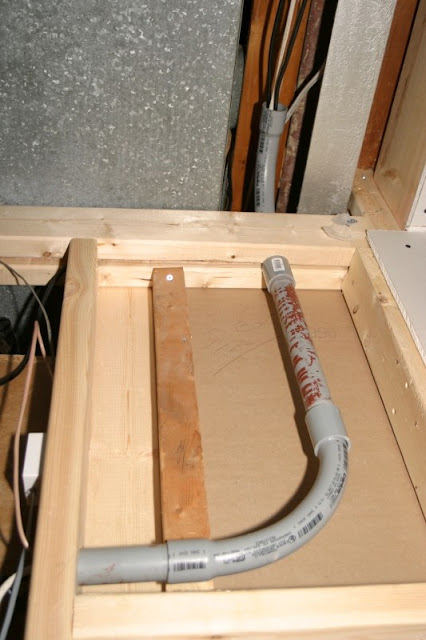Strictly a North American topic this, as we're plagued by the the inevitable 'qualified' cable and phone man who drills holes all around the house seeking the easiest means of ingress for their cable and phone services. My home was not spared and I had no less than 5 holes drilled around the house. More that the holes, was the amount of cable that snaked itself around the perimeter of the house. Most of these were redundant and I set about simplifying the method of ingress for current and future services to the house.
I decided to run a length of conduit from the outside of the house to the location of the distribution panel inside the house and then run cables along with a few spares for any future services.
Here are the tools and materials that I used for the job.
1" Conduit - 2 lengths - Courtesy of my cousin Karl
1" 90 & 45 degree bends - as required - Home Depot
1" junction box for the outside - Home Depot
PVC Adhesive - Home Depot
1 1/2" Bi-Metal Hole Saw - I have this
1 1/2" Carbide Grit Hole Saw - Lowe's
From the inside, I approximated the point of ingress and used the carbide hole saw to make the starter hole through the brick. I followed this up with the bi-metal hole saw to drill through the wood. An extender is required as the hole saw has to pass through one course of bricks and then through 3 inches of wood.
I then ran the conduit, cementing the necessary adapters in place to get the cables to where I wanted them to go. Sealed off the inside and outside holes with expanding foam and silicone respectively and anchored the conduit to the floor joists.
I ran three RG-6 cables, two to the Rogers box, one to the HDTV antenna and one Cat6 cable to the Bell box. The conduit itself has enough space for another three cables. As it stands, the Cat6 and one RG-6 cable have no immediate function as a single RG-6 carries both the phone and the internet and could also carry cable if so desired at a later date.
Not my house, but my neighbors. It illustrates the kind of situation that I had as well. That's the Bell box on the main Hydro pole
The Rogers box mounted in another location
After - The Rogers box moved closer to the Hydro pole and the Bell box
The smaller box is the cable ingress.
From the inside. I got carried away with the expanding foam. This will all be covered when the headers have been insulated
The cables exiting before reentering the wall cavity. This part will be covered with a removable service panel
The conduit in the wall cavity. Will be sealed with drywall
Finally entering the service panel




















